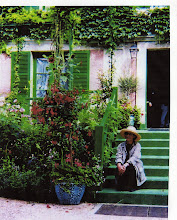Dirt is the stuff you have on your clothing, hands, face, and floor that you want to clean off - it's disposable.
Soil is a fully living organism. it lives, it breathes, it needs to be fed and watered, it needs to be handled with care and yes, reverence.
Soil is earth, earth is where we live.
On Nantucket we all have the opportunity to become land stewards, not just in supporting our various wonderful conservation groups, or trekking and loving our considerable conserved lands - but at home, every day.
In working with Nantucket soils either in a mode of Restoration Ecologist, or as a Gardener I have learned a great deal about our soils. We have a good selection of soil types - of course mostly sandy, but there are pockets of clay, good fields of loam. What is consistent in them is that they are acidic - due in great part to the amount of rain we receive, and the quality of the rain (no acid rain is not gone). Rain is not exclusively the acidifier, sand is really just tiny rocks, there isn't much humus between those rocks to hold buffering agents that would modify the soil pH.
These sandy, or clay soils with low pH ( acidic) are great for the native plant communities we enjoy, and that make our island special. Not so great for gardening with non-native plants, or for growing vegetables.
When I restored the Birds Foot Violet at the airport some years ago I was working with soils that had been stored for the better part of a year. And I learned my first big lessons on Nantucket soils.
Standard practice, one pile for the "top soil" another for "sub soil". Same as for home builders - the dark soil is considered top soil, the yellowish soils is the sub soil.
Top soil is dark because it has silt and organic matter in it - and supposedly when we put that down it is good to plant in.
What I have learned is that stored top soil is not alive soil, it is dark, but it is dead. Without active growth to keep the micro organisms alive, and humus accumulating, it just leaches out life. You can see this when you dig into it - it "plates" breaks apart in little shelves. Add to that is that it probably was applied with heavy equipment and is squashed. No self respecting plant is going to grow in this soil - including native plants.
If you are spreading "top soil" expect to amend it. Compost, Peat moss, Manure - well mixed in, a bit of organic fertilizer to feed the micro organisms and cover it - plant it to get the life force active once more. If you are not ready to place permanent plantings then use a soil enhancing "cover crop" to give it life, and to prevent erosion.
Nantucket soils are extremely fragile. It is "thin" soil. Our soil erodes easily - sandy mixes blow away, wash away, leach away. Leaving "open" soil anywhere is in my book unforgivable - it is asking destruction. If you are in construction, cover crop what you can until you can move your soils where you want them permanently . This will keep them from eroding while stored, and keep the soil alive while stored.
I've a long history with soil, my mother grew up in a region that experienced the worst man made environmental disaster this country has every experienced - the infamous Dust Bowl of the middle west. A short grass prairie that had survived as a functioning and beautiful ecosystem for eons - destroyed in a decade by government supported "farming" efforts, the mold board plow, greed, and ignorance. Read " The Worst Hard Times" for the full effect, and then remember: Nantucket is a short grass prairie.

No comments:
Post a Comment